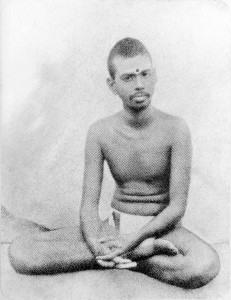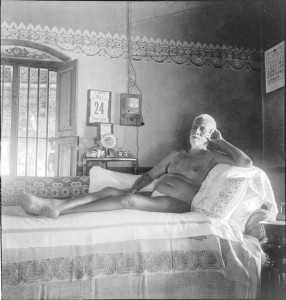Reminiscences
Ramana’s first Western devotee was F. H. Humphrys. He came to India in 1911 to take up a post in the Police service at Vellore. Given to the practice of occultism, he was in search of a Mahatma. His Telugu tutor introduced him to Ganapati Sastri, and Sastri took him to Ramana. The Englishman was greatly impressed. Writing about his first visit to the sage in the International Psychic Gazette, he said:
The Sastriar told me to look the Maharshi in the eyes, and not to turn my gaze. For half an hour I looked Him in the eyes, which never changed their expression of deep contemplation… I could only feel His body was not the man; it was the instrument of God, merely a sitting motionless corpse from which God was radiating terrifically. My own sensations were indescribable… He is a man beyond description in His expression of dignity, gentleness, self-control, and calm strength of conviction.
Humphreys’ ideas of spirituality changed for the better as a result of his contact with Ramana. He repeated his visits to the sage and recorded his impressions in his letters to a friend in England that were published in the Gazette mentioned above. In one of them he wrote, “You can imagine nothing more beautiful than his smile.” And again, “It is strange what a change it makes in one to have been in his presence!”
Not only good people went to the Ashram. Sometimes bad ones turned up also – even bad sadhus. Twice in the year 1924 thieves broke into the Ashram in quest of loot. On the second of these occasions they even beat the Maharshi, finding that there was very little for them to take away. When one of the devotees sought the sage’s permission to punish the thieves, the sage forbade him, saying:
“They have their dharma, we have ours. It is for us to bear and forbear. Let us not interfere with them.” When one of the thieves gave him a blow on the left thigh, he told him: “If you are not satisfied you can strike the other leg also.” After the thieves had left, a devotee enquired about the beating. The sage remarked, “I also have received some puja,” punning on the word in Tamil (poosai) which means ‘worship’ but is also used to mean ‘blows’. The spirit of utter harmlessness that permeated the sage and his environs made even animals and birds make friends with him. He showed them the same consideration that he did to the humans that went to him. When he referred to any of them, he used the form ‘he’ or ‘she’ and not ‘it’. Birds and squirrels built their nests around him. Cows, dogs and monkeys found asylum in the Ashram. All of them behaved intelligently – especially the cow Lakshmi. He knew their ways quite intimately. He would see to it that they were fed properly and well. And, when any of them died, the body would be buried with due ceremony.
Life in the Ashram flowed on smoothly. With the passage of time more and more visitors came – some of them for a short stay and others for longer periods. The dimensions of the Ashram increased, and new features and departments were added – a home for the cattle, a school for the study of the Vedas, a department for publication, and the Mother’s temple with regular worship, etc. Ramana sat most of the time on a couch in what is known at the Old Hall, a silent witness to all that happened around him. It was not that he was not active. He used to stitch leaf-plates, dress vegetables, read proofs received from the press, look into newspapers and books, suggest lines of reply to letters received, etc., yet it was quite evident that he was apart from everything. His speech had the quality of silence, his movements that of stillness. There were numerous invitations for him to undertake tours. But he never moved out of Tiruvannamalai, and in the latter years not even out of the Ashram. Most of the time, everyday, people sat before him, mostly in silence. Sometimes some of them asked questions; and sometimes he answered them. It was a great experience to sit before him and to look at his beaming eyes. Many did experience time coming to a stop and a stillness and peace beyond description.
The golden jubilee of Ramana’s advent at Tiruvannamalai was celebrated in 1946 and a published souvenir was brought out to mark the occasion. In 1947 his health began to fail. He was not yet seventy, but looked much older. Towards the end of 1948 a small nodule appeared below the elbow of his left arm. As it grew in size, the doctor in charge of the Ashram dispensary cut it out. But in a month’s time it reappeared. Surgeons from Madras were called, and they operated. The wound did not heal, and the tumour came again. On further examination it was diagnosed that the affliction was a case of osteosarcoma, an extremely painful form of bone cancer. The doctors suggested amputating the arm above the affected part. Ramana replied with a smile: “There is no need for alarm. The body is itself a disease. Let it have its natural end. Why mutilate it? Simple dressing of the affected part will do.” Two more operations had to be performed, but the tumour appeared again. Indigenous systems of medicine were tried, and homeopathy too. The disease did not yield to treatment. The sage was quite unconcerned and was supremely indifferent to suffering. He sat as a spectator watching the disease waste the body. But his eyes shone as bright as ever and his grace continued to flow towards all beings. Crowds came in large numbers. Ramana insisted that they should be allowed to have his darshan. Devotees profoundly wished that the sage should cure his body through an exercise of supernormal powers. Some of them imagined that they themselves had had the benefit of these powers which they attributed to Ramana. Ramana had compassion for those who grieved over the suffering, and he sought to comfort them by reminding them of the truth that Bhagavan was not the body: “They take this body for Bhagavan and attribute suffering to him. What a pity! They are despondent that Bhagavan is going to leave them and go away – where can he go, and how?”
The end came on the 14th of April 1950. That evening the sage gave darshan to the devotees that came. All that were present in the Ashram knew that the end was nearing. They sat singing Ramana’s hymn to Arunachala with the refrain ‘Arunachala-Siva’. The sage asked his attendants to make him sit up. He opened his luminous and gracious eyes for a brief while; there was a smile; a tear of bliss trickled down from the outer corners of his eyes; and at 8:47 the breathing stopped. There was no struggle, no gasping, none of the signs of death. At that very moment, a brilliant star-like object slowly moved across the sky, reached the summit of the holy hill, Arunachala, and disappeared behind it. It was seen in many parts of India, even as far as Bombay (Mumbai).


